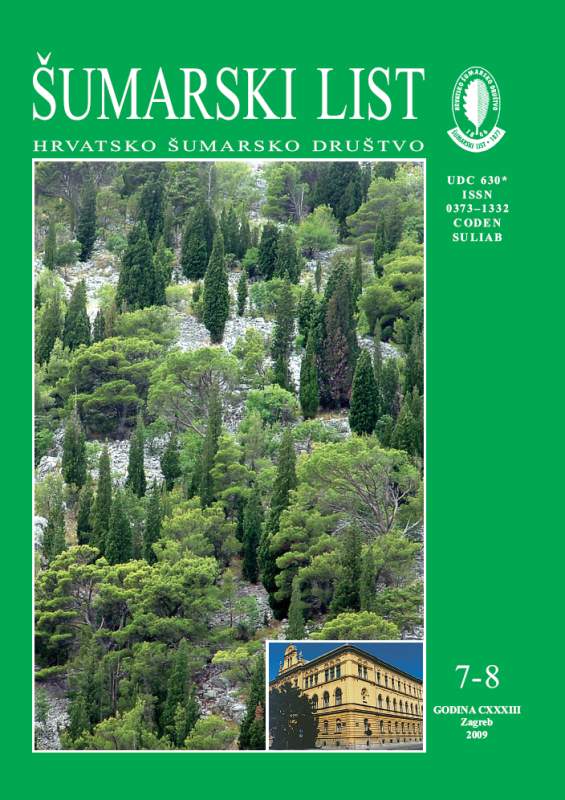
broj: 7-8/2009
pdf (8,4 MB) |
|
||||||||||||||
| RIJEČ GLAVNOGA UREDNIKA | ||
| Branimir Prpić | ||
| MORE ABOUT FORESTS AND NATURE PROTECTIONIN RELATION TO NATURA 2000 IN CROATIA pdf HR EN | 368 | |
| IZVORNI ZNANSTVENI ČLANCI | ||
| Vedriš,M., A.Jazbec, M.Frntić, M.Božić, E.Goršić | UDK 630* 529 (001) | |
| Precision of Structure Elements’ Estimation in a Beech – Fir Stand Depending on Circular Sample Plot Size pdf HR EN | 369 | |
| Matošević,D., M.Pernek, T.Dubravac, B.Barić | UDK 630* 453 (001) | |
| Research of Leafminers onWoody Plants in Croatia pdf HR EN | 381 | |
| Dubravac,T., S.Dekanić | UDK 630* 423 (001) | |
| Structure and Dynamics of the Harvest of Dead and Declining Trees of Pedunculate Oak in the Stands of Spačva Forest from 1996 to 2006 pdf HR EN | 391 | |
| Godina, K. | UDK 630* 569 (001) | |
| Development Structure Elements in Mixed Oak Stands in Aria of ForestAdministration Bjelovar with Retrospect on Modelling Growth andYield of Mixed Stands pdf HR EN | 407 | |
| Cerovečki, Z. | UDK 630* 188 (001) | |
| Beech Forests and Milava –As.Calamagrosti arundinaceae-Fagetum(Ht. 1950) Cerovečki ass. nov. of the Mountain of West Croatia pdf HR EN | 417 | |
| STRUČNI ČLANCI | ||
| Pašičko,R., D.Kajba, J.Domac | UDK 630* 425 (biomasa–Biomass) | |
| Impacts of EmissionTrading Markets on Competitiveness of Forestry Biomass in Croatia pdf HR EN | 425 | |
| Summary: A rising share of renewable energy sources in the overall energy balance is one of the strategic goals of a growing number of countries. By signing international agreements (e.g. the Kyoto Protocol), and in accordance with the legislature and accession to the EU, Croatia undertook the obligation to make concrete steps and increase the use of renewable energy sources, as stated by the paradigm “sustainable development”. In Croatia, biomass is a renewable energy source with the greatest potential. The goal of this work is to explore the impact of the European Emission Trading Scheme (EU ETS Scheme) and flexible mechanisms of the Kyoto Protocol – the Joint Implementation Mechanism, JI, and the Clean Development Mechanism, CDM, – on the competitiveness of biomass energy production. Compared to fossil fuels, the advantage of biomass is that energy from biomass combustion is considered CO2free technology, since biomass sequesters CO2as part of photosynthesis. The EU ETS restricts emission amounts at the national level and at the level of single installation. Every industrial operator is allocated a certain amount of emission allowances. In order to satisfy their needs, the operators may trade with their allowances and purchase emission allowances on the market. The JI and CDM projects represent flexible Kyoto mechanisms which allow investment in emissions reduction outside the investing country. The amount of emissions reduced in such projects is used to satisfy the allowances of the investing countries, while the price of CO2emissions per ton is determined by the market. An allocated amount of emissions which an installation or a country may emit increases the competitiveness of low-carbon technologies. Forest management and exploatation produces large quantities of forest biomass, which can be used for energy production. Biomass can additionally be generated by the establishment of bioenergy plantations and biomass production in short rotation crops (SRC) of forest tree species. The article presents a mathematical economic model which explores the impact of CO2prices on investment decisions related to the construction of new electrical power plants or a change of fuels in the existing plants. The model determines emissions allowance prices at which biomass becomes more competitive than other technologies. Changes in CO2prices affect short run marginal costs (SRMC) and long run marginal costs (LRMC) of electrical energy production, where a decision on the replacement of fuel in the existing plant depends on trends in short run marginal costs, whereas an investment decision to construct new electrical plants depends on long run marginal costs. According to the results of the applied model, biomass fuel in the existing plants (comparison of SRMC) is more competitive than gas even with minimal biomass prices and no additional CO2allowance price or feed-in tariffs. With CO2prices larger than 26 €/t CO2, biomass becomes more competitive than gas and coal for its minimal price, while for its maximal price it is more competitive at CO2prices larger than 21 €/t CO2. Key words: Croatia; EU ETS scheme; forest biomass; short run (SRMC) and long run marginal costs (LRMC) | ||
| Grgurević, D. | UDK 630* 272 (Cactaceae) | |
| Succulents (fat plants) on theAdriatic Coast and their Use in Parks pdf HR EN | 439 | |


